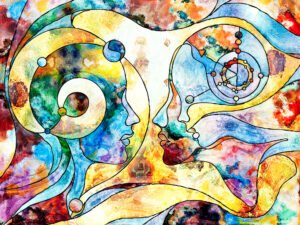Mental health, a topic traditionally dominated by psychiatric and psychological theories, is undergoing a profound evolution. A recent study highlights the increased richness and diversity of mental health models that are being used to frame our understanding of the mind, madness, and emotional suffering.
Researchers Dirk Richter from Bern University of Applied Sciences and Jeremy Dixon from the University of Bath published a quasi-systematic review of theoretical models of mental health problems in the Journal of Mental Health. Their work highlights the diverse landscape of models and approaches that have sought to understand, describe, and analyze mental health issues.
The traditional dominance of psychoanalytic and social theories from the 1940s to the 1970s shifted to a biomedical paradigm in the 1980s and 1990s. But as the 21st century progresses, challenges to singular perspectives have multiplied.
“Contemporary arguments about the nature of mental health problems have tended to focus on the tension between polar positions, i.e., biomedicine or the critical perspectives proposed by the user/survivor/critical psychiatry camps. While the bio-psycho-social model has been used to hold divergent perspectives together, this consensus seems to be fracturing,” Richter and Dixon note.
Drawing from a wealth of resources, from academic articles to books, this new study identified 34 distinct models of mental health problems. These were categorized into five broader groups: biological, psychological, social, consumer, and cultural.

Mental health and mental illness have been subjects of contention across various fields, from medicine to sociology, for many years. From the 1940s to the 1970s, the discourse was dominated by psychoanalytic and social theories. However, the 1980s and 1990s saw a shift towards biomedical models, peaking in the 1990s when it was named the “Decade of the Brain” by the U.S. Congress.
As the 21st century commenced, the understanding and classification of mental health problems became more disputed, especially with the release of the fifth edition of the American Psychiatric Association’s Diagnostic and Statistical Manual (DSM-5). Criticisms were not only external but also from within the biomedical community, leading to significant debates.
The biomedical community has been embroiled in discussions regarding dimensions versus categories of symptoms, the aetiology of mental disorders, and the comorbidity of distinct disorders, among other topics. Recent network research has questioned the existence of hundreds of separate disorders, suggesting instead the presence of only a handful of overarching dimensions.
Practical questions persist, with definitions of mental health problems influencing legal and policy decisions. A compelling need has arisen for comprehensive mental health model reviews encompassing diverse perspectives, especially those of service users. The researchers’ choice of the term “mental health problems” was intentional, striving for consistency and inclusivity across varied publications.
The researchers conducted a quasi-systematic review of mental health theories and models, primarily using databases like Pubmed, CINAHL, and PsycINFO and also searching Amazon.com. The study aimed to understand the diversity of models from 2000 onwards in various languages, excluding empirical and purely philosophical works.
For methodological transparency, they registered the study with the Open Science Framework. The extensive and varied data were presented graphically, with detailed models tabulated and a list of all referenced publications provided as supplementary data.
 Brief details of identified models from Dirk Richter & Jeremy Dixon
Brief details of identified models from Dirk Richter & Jeremy DixonTheir research synthesized 110 out of 3423 publications, grouping them into five pivotal categories: Biology, Psychology, Social, Consumer, and Cultural.
- The Biology category primarily emphasized the brain’s role in mental health and the need for a brain-based taxonomy.
- The Psychology category housed theories like salutogenesis, cognitive psychology, psychoanalysis, network psychology, and existentialism, each proposing distinct lenses to view mental health.
- The Social category highlighted the influence of social factors on mental health, with models emphasizing socially induced constraints and the effects of real-world events.
- The Consumer category consisted of models reflecting the experiences of those treated by mental health services, emphasizing recovery, normalizing mental health concepts, and stressing the significance of patients’ experiences.
- The Cultural category addressed cultural, traditional, and spiritual interpretations of what is termed as illness in psychiatry.
Several models merged two or more primary categories, forming a spectrum of interdisciplinary approaches. For instance, biopsychology bridges biology and psychology, encompassing sub-models like network biopsychology and neuropsychology.
Psychosocial models, sitting between the psychology and social categories, focused on the interplay between individual psyche and societal factors.
Radical approaches and anti-psychiatry models, positioned between the social and consumer categories, either aimed to liberate those with mental health issues from existing paradigms or critically questioned the existence of mental illness.
Some models drew non-linearly from the five primary categories, such as ethnopsychology, which intertwines cultural and psychological insights. The study emphasizes the diversity and complexity of models and approaches in understanding mental health problems.
Richter and Dixon speculate on the increasing diversity of mental health models. The drive for specialization in science, dissatisfaction with conventional classification approaches like the DSM, and the emerging voices from non-medical professions all contribute to this growing diversity.
“We conclude that mental health care needs to acknowledge the diversity of theoretical models on mental health problems.”
Their work emphasizes the need for a more holistic and inclusive view that moves beyond the traditional psychiatric and psychological lenses.
This review offers the first comprehensive look at models of mental health problems using a systematic review methodology. By examining various sources from natural and social sciences, service users, activists, and traditional or spiritual/cultural approaches, a myriad of perspectives on the definition and aetiology of mental health problems have been identified.
The research includes a vast array of models, both old and new, such as psychoanalysis and computational neuroscience. A vital takeaway is that more recent models don’t necessarily eclipse the older ones but rather augment them.
Their findings highlight the diverse goals associated with different models. For instance, while some models advocate for a purely biological or psychological understanding, others lean towards political or legal solutions.
The study underscores a pivotal shift: the definition of mental health problems should be collaborative, integrating insights not just from the medical sector but also from the communities directly impacted.
The study presents two overarching theoretical approaches: the first acknowledges the coexistence of diverse models, advocating “Epistemic Pluralism.” The second proposes an overarching meta-theory, promoting novel research methodologies, drawing from “Post-psychiatry” and “polycontexturality.”
This requires clinicians to attain “Conceptual competence,” ensuring they recognize varied foundational concepts and assumptions and don’t misinterpret them as symptoms of illness.
Moreover, a multifaceted approach can address legal and political challenges, especially regarding the rights of service users. Lastly, amplifying the voices of non-medical professionals and service users in discussions about mental health models is crucial, fostering collaborations between them and academics for a more comprehensive discourse on mental health challenges.
****
Richter, D., & Dixon, J. (2023). Models of mental health problems: a quasi-systematic review of theoretical approaches. Journal of Mental Health, 32(2), 396-406. https://doi.org/10.1080/09638237.2021.2022638 (Link)
Editor’s Note: Part of MITUK’s core mission is to present a scientific critique of the existing paradigm of care. Each week we will be republishing Mad in America’s latest blog on the evidence supporting the need for radical change.

Thank you Justin,
I agree with your narrative and I am committed to see real changes in Mental Health and psychiatry. I am fully aware that this specialty does NOT practice medicine. There is very poor Medical History taking, collaborative working, blood testing, ordering of investigations, further dialogue and critical thinking. Medicine is an art which is to be practised with humility. Values from medical ethics of respect for autonomy, non-maleficence, beneficence and justice are completely ignored.
Psychiatrists are adamant that they are correct in the diagnostic procedure forgetting that they are accountable for their actions and decision makings. They have drawn conclusions with no scientific basis or Evidence Based Medicine. They have merely turned to a random page in a book and decided this is what fits. In their haste to diagnose, they treat and manage by prescribing a whole range of what are highly likely to be prescription errors. Yet, they fail to realise their initial mistake of misdiagnosis. When the patient does not respond to psychoactive treatment, they then decide another type and a stronger dose. So, a person ends on multiple harmful drugs.
They are so far removed from medicine that they actually miss physical diseases. Yet, it is their own egos and narcissistic tendencies that come into play. The attitudes of those working in Mental Health will be and has to be addressed. MANDATORY General medical training has to be incorporated into their studies and work.
When they fail to realise that a patient is suffering from a physical disease which has neuropsychiatric symptoms, they are indeed showing that they are incompetent. When they make drug errors, they are proving that they are dangerous. When they fail to understand that a person has an individual faith, is from a different country, culture and has a different lifestyle, they are failing to understand the person. It is seen all too often in the Mental Health, I am the doctor, I must be right. However, not only had the “doctor” and I use the term loosely, undertaken this but they have convinced a huge range of other people too. This person has “schizophrenia” as an example.
No, the patient has Huntington’s disease. They will also have neurological symptoms, difficulty moving, sitting, standing, feeding themselves, difficulty swallowing and need lots of support from a neurologist, speech and language therapist, physiotherapist, occupational therapist. It is an inherited disorder. So, a genetic blood test is undertaken for diagnosis. So, “doctor”, six months ago you decided to detain a very physically sick person under the Mental Health Act (1983). I am afraid that they do not have a ‘Mental Health disorder’. Therefore, you have broken Human Rights Act (1998) and the Equality Act (2010) and in 1971, Phillip Zimbardo, psychologist proved how easy people would obey those in AUTHORITY.
How many people did you tell that this person had a MH disorder ? 40 was it ? Or nearer 60 or 100 ?
Hans Christian Anderson wrote a fable, The Emperor’s New Clothes. The story of a person in a high position who is too proud to realise that they have been exposed.